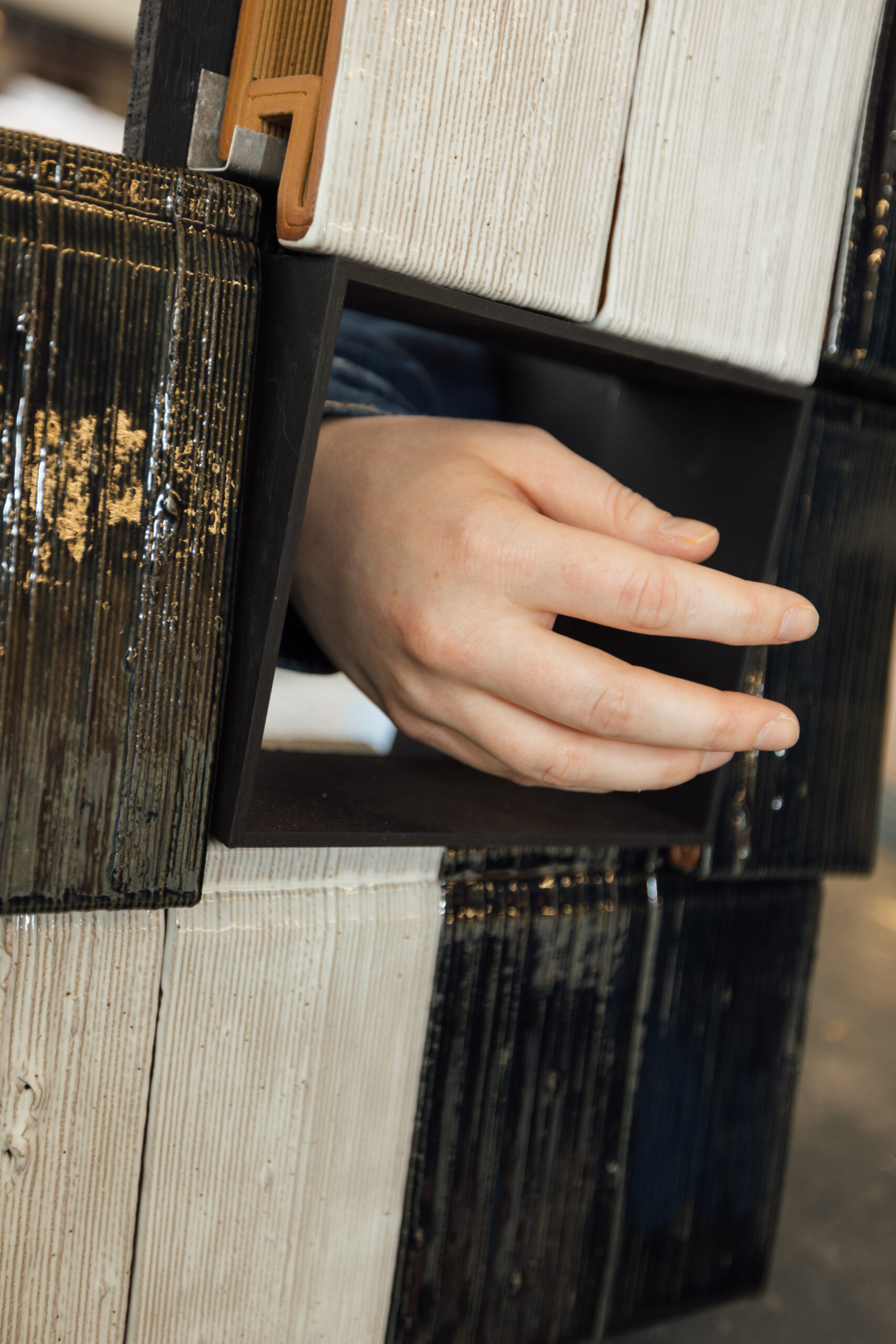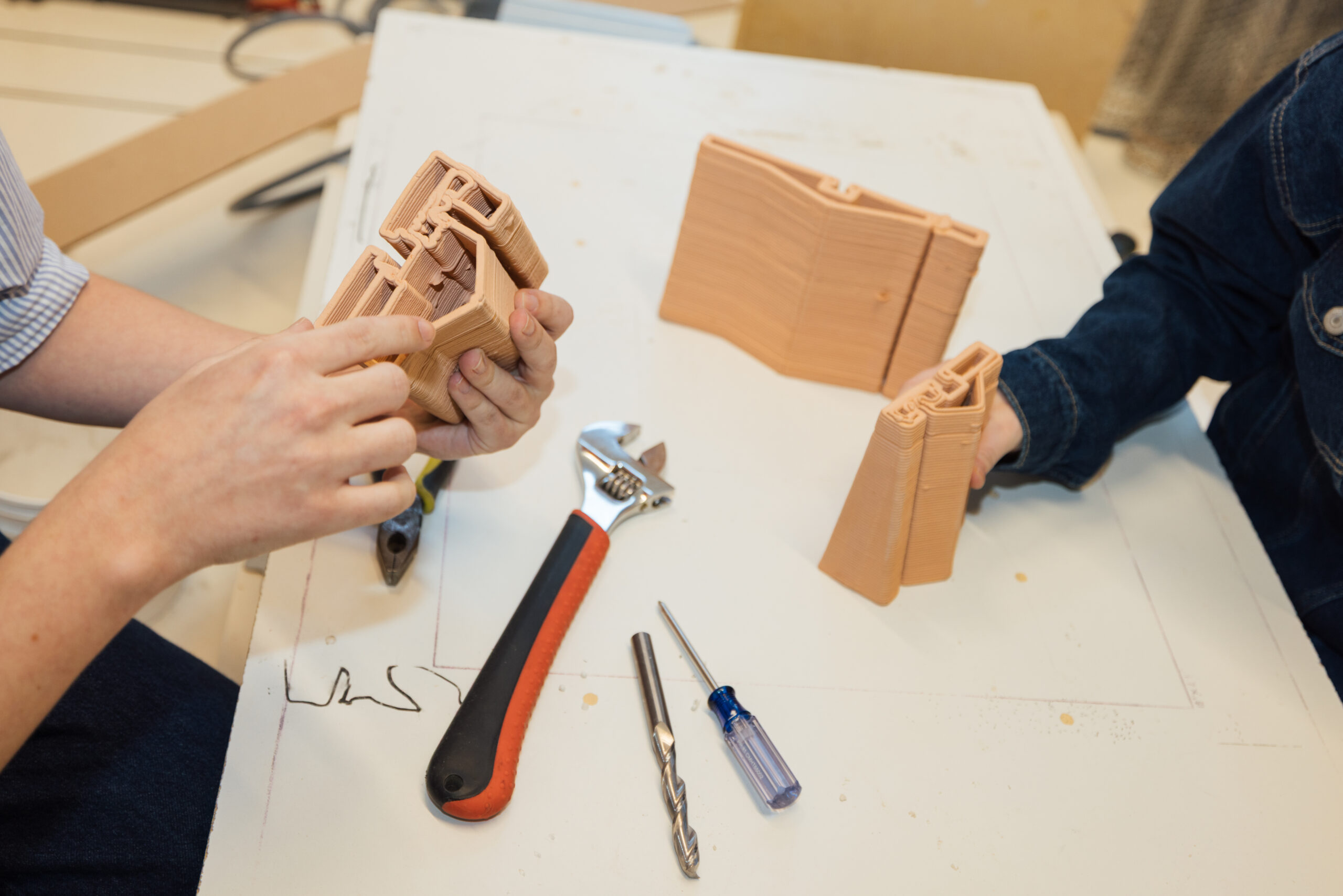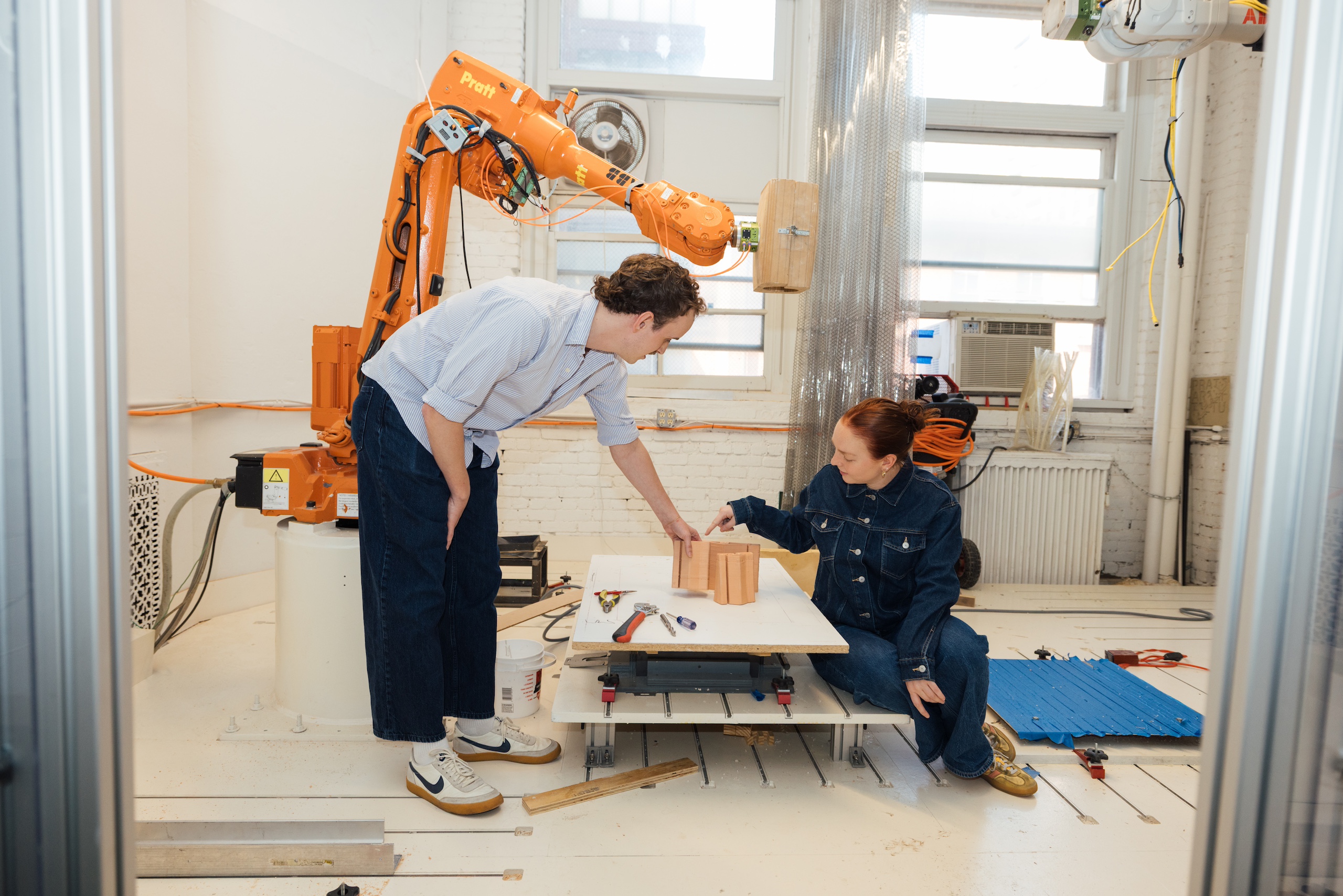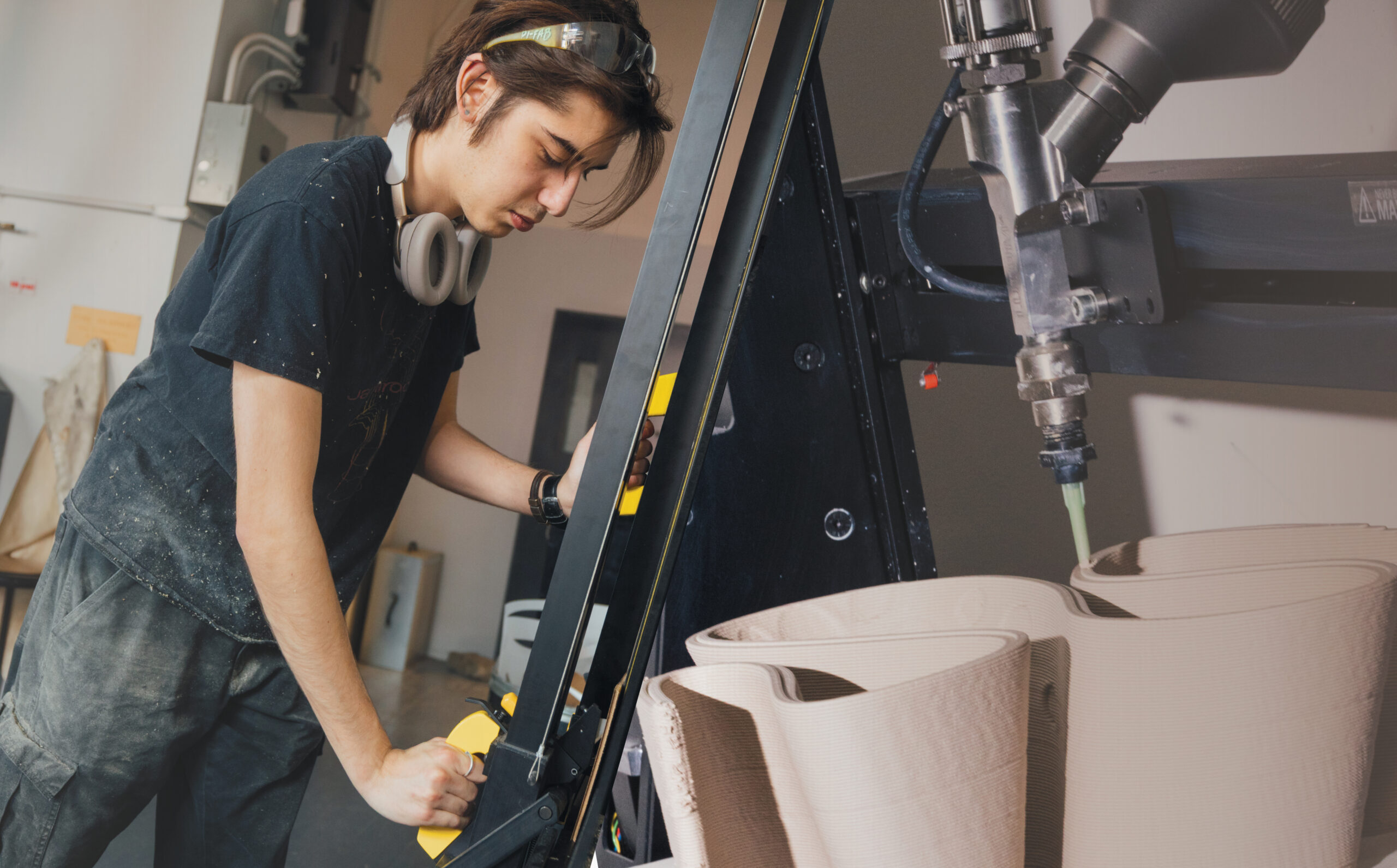This story is from Prattfolio’s feature “Mill, Melt, Press, Shape,” on students working across mediums in Pratt’s shops and labs.
Master of Architecture students Kerry Richardson and Colin House, both finishing their second year in the program, met Prattfolio in the School of Architecture Robotics Lab and studios to talk about their experiments and successes in 3D printing with clay. For an assignment to design building facades, both designed clay brick systems and used the robot to make their models, working together to navigate an unconventional and inventive process.
What brought you to Pratt?
KR: I studied biology and chemistry in undergrad. So something completely different from architecture. I wanted to do something more design focused, where I could be more creative, and I thought back to classes I took in high school, when I was on the engineering track. I’d taken a civil engineering and architecture class, and I really liked 3D modeling and being in the woodshop there. So, I took a summer class at Pratt, intro to architecture, and I really liked it, so I applied for master’s programs. I was mainly focused on schools in New York City.
CH: I was always interested in fabrication. In high school, I took woodshop. Going to undergrad, I did architecture history, instead of full-blown design. I really got into history, the background behind design concepts. I’d actually applied to Pratt for undergrad and I didn’t go, but I circled back for my graduate degree. I think design was waiting for me the whole time, but I never took the leap until now.


How did you get to this place, 3D printing with clay?
KR: The project was to design a facade, so when we were researching precedents—just buildings that we like the facades of—one of the ones I chose was made of ceramic tile. [A Factory as It Might Be by Assemble Studio.] It wasn’t 3D printed; it was this simple extrusion of clay. I also liked the fact that you can make this any color you want. I’m really interested in color in my designs.
Then I found out that we can print clay. I started by making molds. I’d 3D print a mold and put the clay in, and have that as my tile, but it’s easier printing clay with the robot.
CH: We all have our own 3D printers [in the master’s program], so we’d been introduced to that process, but I work at the shops here and I knew that the robot is capable of doing clay 3D printing. So, we were interested in ceramics as a base point, and it was sort of like, OK, if we’re interested in ceramics, and we already know a bit about 3D printing, why don’t we try this. [Kerry and I] weren’t even in the same class—but we thought, let’s just do it together.
KR: We just found each other doing the same thing.
CH: [As precedent] I was inspired by 212 Stuart Street by Höweler + Yoon, an apartment complex building. They used concrete panels as the facade, not ceramic. But I chose that one because it had this wavy form that drew me to it. I wanted to combine that shape with the materiality of clay and see what happens when you combine the two.

What did you discover in the process?
KR: There was so much trial and error. With the type of clay you’re using, the speed that you’re printing, how many wall layers you have. I had to build two layers for it to stand up at this height. How you’re packing the clay, how wet the clay is when you’re packing it into the tube, how much clay you need for each piece, because sometimes you can print one, but then you’re almost running out, and then it only prints a half and you have to repack the whole thing.
CH: It really did depend on the type of clay that we use. We started out with a clay that was super groggy—it had sand and silt and gravel. It was very chunky, textured clay, and that wasn’t working at all with the 3D printer. It didn’t hold moisture, and it didn’t go through the extruder properly with the nozzle, because it would just get clogged. And you really need to have a consistent sort of hydration level to have it come out as cleanly as possible.
KR: Yeah. We kept going with that clay because we really wanted to make it work, because we paid for it. Until we were like, OK, this actually is not working. We need to find something smoother. Once we found this [terra-cotta with no grog], we were printing like five pieces a day.

CH: We would come in at like 8 AM, pack the tube, submit the files, and then just stay there all day. We air dried for three to four days, and then, after [the pieces] dried completely, we brought them to this artist in Bushwick who owns her own studio and has a kiln that she rents out. She would fire them and we would get them back within the week. The bisque fire is the first process—these [Colin’s pieces] are just bisque fired, so they have that natural terra-cotta tone—and Kerry went back for the glaze.
KR: I wanted to include color. The glaze, you never know how it’s going to come out. This is supposed to be a dark blue-green, but it’s really dark—it could’ve been the temperature it was fired at, or the way I painted it. It’s all experimentation.
CH: I don’t think either of us have ever worked with clay. Greg [Sheward, School of Architecture production facilities manager and visiting assistant professor] pointed us toward resources, and we took that info dump and then ran with it from there.
KR: We were making our own profiles, finding our own clay—
CH: We were creating the geometry in Rhino, with no idea how well it would print on the robot. Every project in the robot lab is so different, that there’s not really a textbook “here’s what you have to do.”

KR: We also had to custom make all our metal in the metal shop. We decided to buy sheet metal, go downstairs and chop everything up, fold it, drill holes in it for us to screw it back on the wood.
CH: A part of the class was to investigate a material, but then create your own system for how it connects to the facade. Kerry used a horizontal railing system, where profiles slid into each other. Mine used vertical I-beams, and the profiles slid down vertically. We came up with the designs the second week of the semester, and the rest of the semester was all trial and error in the fabrication process.
KR: We had to start as soon as possible because everything takes so much time.
Did you have any interesting failures?
KR: When we were using the other [groggy] clay, I printed a tile; I just really wanted to get one print done that day. I was doing it all day. I printed one, I stepped out, and when I came back it had collapsed. That was when I was like, I’m done with this clay. We need to get another clay. But once we got this clay, it went really smoothly.
CH: I had problems with the Grasshopper script that we were using to slice the object. It didn’t work for months and months, and I ended up just referring back to what we initially started to do, just drawing the tool path, drawing every single layer of the entire model and stitching them together to tell the robot what to do. Mine was 70 layers.

How has working with other students in the shops shaped your work?
CH: With the robot, students come in with files and we work through the files together with Greg, because it has a really big learning curve. In the woodshop, it’s more hands-on. It’s definitely helped that we have a community that we’ve built up—we have people who’ve got our backs and want to see us succeed, and they put in a lot of time and effort to help us through whatever mishaps we run into.
What advice would you give to someone figuring out how to navigate these spaces?
KR: Talk to people. I was so intimidated by the woodshop, and it took me forever to get in there and use the bandsaw, but I went and asked for help. In the robot lab as well.
CH: Everyone who goes to Pratt is excited to make something, so they’re always down to help you. They will get behind your idea no matter how awful it is [laughs]. You don’t get that level of community at every school.
Photos by Dahlia Dandashi


